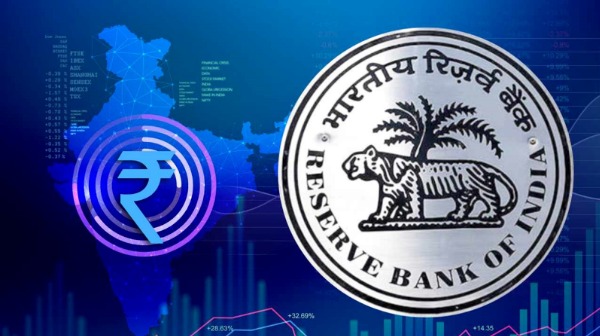
The Reserve Bank of India said on Tuesday that retail digital rupee rbi (eRs-R) would be introduced on December 1 as a pilot programme. The pilot would cover a few sites in a closed user group (CUG) made up of participating customers and merchants, according to a statement from RBI.
The main objective of the implementation of digital rupees is the steady phase-out of paper money, which would reduce the expense of managing and carrying paper money. The Digital Rupee rbi , often known as e-Rupee, is not a cryptocurrency and is not based on the Blockchain. Bank of America A digital version of cash or paper money is known as digital currency (CBDC). This implies that the value of the paper rupee and the digital rupee is equivalent.
In four cities—Mumbai, New Delhi, Bengaluru, and Bhubaneswar—four banks—State Bank of India, ICICI Bank, Yes Bank, and IDFC First Bank—have begun the Digital Rupee rbi Pilot Program. The RBI will add four more institutions to the collaboration when the testing phase starts: Bank of Baroda, Union Bank of India, HDFC Bank, and Kotak Mahindra Bank. The programme will be extended to more cities in the following days. In the second phase, digital rupees will be available in a number of cities, including Ahmedabad, Gangtok, Guwahati, Hyderabad, Indore, Kochi, Lucknow, Patna, and Shimla. You can learn everything about digital currency right here.
What is retail Digital Rupee RBI ?
The Reserve Bank of India thinks that because the retail digital rupee rbi is a direct liability of the central bank, it can offer access to safe money for payment and settlement. Retail CBDC is, to put it simply, an electronic version of cash that is mostly used for retail transactions.
The retail digital rupee’s presentation:
The Reserve Bank of India released a concept note on October 7, 2022, which states that the central bank has suggested a token-based tiered architecture approach for the retail digital rupee rbi. Similar to banknotes, a token-based CBDC is assumed to belong to whoever is holding it. In a CBDC that uses tokens, the recipient of a token will confirm that it truly belongs to him. As it would be more similar to actual money, “a token-based CBDC is considered as a preferred option for CBDC-R,” the RBI previously stated.
Who will issue and manage the retail digital rupee rbi?
According to the concept note, a two-tier distribution mechanism is suggested for the retail digital rupee rbi. The distribution and payment services will be handled by the banks, while the Reserve Bank of India would issue and redeem e-R. The model is comparable to the current physical currency management system where banks are in charge of managing tasks like issuing notes to the general public, maintaining accounts, adhering to know-your-customer (KYC) and anti-money laundering and countering the financing of terrorism (AML/CFT) checks, transaction verification, etc.
Which banks and cities are taking part in the pilot programme for retail digital rupees?
Eight banks have been chosen to take part in four cities throughout the nation’s retail pilot of the digital rupee in stages. Four banks—State Bank of India, ICICI Bank, YES Bank, and IDFC First Bank—will participate in the test launch in the first phase. Following that, this pilot will include four more banks: Bank of Baroda, Union Bank of India, HDFC Bank, and Kotak Mahindra Bank.
In the beginning, the pilot will only be available in Mumbai, New Delhi, Bengaluru, and Bhubaneswar. Later, it spread to Shimla, Hyderabad, Indore, Kochi, Lucknow, Gangtok, and Patna.
Customers and retailers will currently be able to utilise the e-rupee or digital rupee in the CUG in these cities. Additionally, the retail e-Rupee will be fungible with other currencies. The goal is to transition to a cashless society and give consumers the same rights they have with cash, but mostly through digital means. According to RBI, “the pilot’s scope may be gradually expanded to include additional banks, users, and locations as required.”
Can you use retail digital rupee rbi ?
The closed user groups (CUG) that the retail e-R pilot project will cover comprise both customers and business owners.
According to RBI’s prior concept note, all firms, consumers, including consumers outside of the financial sector may be able to use the retail digital rupee rbi.
How to use e₹-R?
The same denominations that are currently used for paper money and coins will also be used for the e-R. Through a digital wallet provided by the participating banks and kept on mobile phones or other devices, users will be able to conduct transactions with e-R.
“In the pilot, customers will be able to construct a wallet containing digital e-R tokens and use it for a variety of transactions or use cases with specific institutions. The e-R would be compatible with current bank accounts and will function as legal tender supported by the central bank “Mihir Gandhi, Partner and Leader – Payment Transformation, PwC India, said. Both person-to-person (P2P) and person-to-merchant (P2M) transactions are compatible with e-R for. Customers can use the QR codes displayed at merchant locations to pay for goods and services.
Keep in mind that the retail digital rupee rbi can be converted to other currencies, such as bank deposits, but it will not accrue any interest.
“Payments that are affordable, secure, and simple for all”
“RBI CBDC seeks to deliver on the promise of accessible, secure, and easy payments for everyone. The CBDC would result in more strong and dependable payments, reducing the dependence on cash, because it offers a regulated alternative to cryptocurrencies in the market. Because of the underlying technology, transaction costs would be low. It will complete the mobile payments ecosystem by complementing current methods like UPI and being compatible with other payment systems, according to Jaya Vaidhyanathan, CEO of RegTech company BCT Digital.
Types of CBDC to be issued
The general purpose or retail (CBDC-R) and wholesale types of central bank digital currency exist. “CBDC can be categorised into two major forms, namely general purpose or retail (CBDC-R) and wholesale,” said an RBI study from October 7, 2022. (CBDC-W). While wholesale CBDC is intended for restricted access to specific financial institutions, retail CBDC might possibly be available for use by everybody, including private sector, non-financial customers, enterprises, and organisations. Retail CBDC is an electronic version of currency primarily intended for retail transactions, whilst Wholesale CBDC is intended for the settlement of interbank transfers and related wholesale operations.
“Given that retail CBDC is a direct obligation of the central bank, it is thought that it can give users access to safe money for payments and settlement. Wholesale CBDC has the ability to improve the security and efficiency of financial transaction settlement systems. Considering the potential each of them offers, there may be justification for introducing both CBDC-W and CBDC-R “In the concept note, RBI stated.
Forms of CBDC
Either an “account-based” or “token-based” structure can be used for CBDC. With tokens, CBDC
Similar to banknotes, a token-based CBDC is a bearer instrument, therefore whoever is in possession of the tokens at any one time is assumed to be the owner.
Based on accounts CBDC
Contrarily, an account-based system would need monitoring all CBDC holders’ transactions and balances in addition to determining who is the true owner of any monetary amounts.
According to the press release from the RBI, “in an account-based CBDC, an intermediary confirms the identity of an account holder, but in a token-based CBDC, the individual receiving a token will verify that his ownership of the token is legitimate. The token-based CBDC is viewed as a preferred option for CBDC-R since it would be closer to actual currency, while the account-based CBDC may be taken into consideration for CBDC-W when comparing the characteristics supplied by both forms of CBDCs.
Digital Rupee is not cryptocurrency
Comparing the digital Rupee to traditional cryptocurrencies is not accurate. This is also referred to as Central Bank Digital Currency (CBDC), which denotes that the RBI, in this situation, is the backer of the currency. The primary attribute of a cryptocurrency is decentralisation, whereas the RBI issues and controls the digital rupee, and it is the central bank that determines all of the CBDC’s specifications.
Digital rupee rbi would have a set value and be recognised as legal cash in India, unlike cryptocurrencies, whose value changes based on the volume of transactions. Therefore, both person-to-person (p-to-p) and person-to-merchant (p-to-m) transactions can be completed using the digital rupee.
Physical Rupee vs Digital rupee
In most places, this can be used just like a real rupee. You won’t be able to get your money back in the form of actual currency, though. However, commercial banks can be used to exchange digital rupees for cash. Money that is in your bank account typically earns interest. The value of the digital rupee will not change, and it will not accrue any interest.
Cryptocurrency vs. The Digital Rupee RBI
Simply said, a cryptocurrency is unchained money that is not controlled by any central bank or government. It is supported by blockchain technology and secures user transactions with cryptography, making it hard to forge.
Blockchain, decentralisation, and cryptography are the three terms you need to be familiar with in order to better understand cryptocurrencies.
The showrunner of cryptocurrency is the blockchain. It is a digital ledger that keeps track of transactions and distributes access to authorised users.
The registered users each have access to the information. Therefore, everything that is recorded on the blockchain is transparent and unchangeable, meaning that it cannot be altered or compromised. by the administrator not even.
In the case of cryptocurrencies, decentralisation refers to the absence of any central authority over the asset. By using this approach, cryptocurrencies become independent. The RBI also oversees and controls the centralised money that we use.
In the context of cryptocurrencies, cryptography refers to secret writing, so the recipient can only read messages. It handles the transactions, safeguards operational independence, and strengthens the entire chain.
Central bank digital currencies (CBCD)
A CBDC is a form of legal money that is issued in digital form by a central bank, according to the RBI. It is interchangeable one-to-one with fiat currency and is the same as fiat currency. Its only distinction is in form.
A CBDC, however, cannot be directly compared to a cryptocurrency.
A CBDC is not a commodity or a claim on a commodity or digital asset, unlike cryptocurrencies. The issuer of cryptocurrency is absent. As stated in the RBI statement, “They are not money (definitely not currency) as the term has come to be understood historically.
The CBDC, which should be exchangeable for cash, is the digital representation of paper money issued by central banks like the RBI. The digital rupee will serve the same purpose as the widely recognised digital rupee, which is a currency that the RBI creates, but it won’t be a decentralised asset like cryptocurrencies. The currency known as the “digital rupee” will be produced by the central banks in charge of overseeing and administering the asset.
You can use the virtual rupee as legal tender to make purchases of any kind. Examples of digital rupees include digital wallets, NEFT, and IMPS. Therefore, everyone in India will be able to utilise the digital rupee whenever the RBI begins to issue it.
Is the Digital Rupee Necessary?
The RBI’s decision to introduce a digital rupee is primarily intended to advance India in the race for virtual money. And, of course, since cryptocurrencies are becoming more and more important.
The digital rupee will become more efficient and transparent thanks to blockchain technology.
- Additionally, blockchain will make ledger upkeep and real-time tracking possible.
- Both wholesale and retail clients will have constant access to the payment system.
- Indian customers are able to pay directly.
- lower cost per transaction.
- Account settlements in real time.
- To use a digital rupee, you don’t need to open a bank account.
- swift international transfers.
- No volatility risk because the RBI will support it.
- In contrast to paper money, the digital rupee will always be portable.
But can CBDCs step up their game in the face of a massive payment system like UPI?
Cash continues to be the preferred method of payment for obtaining funds for regular expenses, according to a poll by the RBI. Cash is primarily utilised for low value transactions (amounts up to INR 500).
FAQ Related to Digital Rupee e₹
When will the digital rupee be introduced in India?
The Reserve Bank declares December 1, 2022, as the launch date for the first pilot programme for retail digital rupees (e₹). It may be noted that RBI had stated in a press release dated October 31, 2022, that the pilot in e₹ would begin in one month.
Is digital rupee safe?
The e₹ is secure because it carries a sovereign guarantee, just like cash, according to the RBI. Digital transactions are secure and getting more secure. The goal of digital money is to provide a reliable, easy-to-use payment mechanism for the average person. The unbanked are also integrated into the banking system.
Digital rupee RBI: Is it real?
The Reserve Bank of India’s official form of money is the Central Bank Digital Currency (CBDC), according to the concept note. According to the regulator, the CBDC, also known as the Digital Rupee or e-Rupee, issued by the RBI, is interchangeable 1:1 with fiat money and functions similarly to a sovereign currency.
How does the digital rupee (rbi) function?
E-rupees will be distributed through intermediaries, namely banks, and will be issued in the same denominations as coins and paper money. Users will be able to conduct transactions using e₹ using a digital wallet provided by the collaborating banks and kept on mobile phones and other devices, according to the central bank. According to the RBI’s statement, digital rupee transactions can be made between individuals and businesses (P2P) as well as between individuals and merchants (P2M).
What is the advantage of digital rupee?
It is thought that as retail CBDC is a direct responsibility of the central bank, it can provide customers with access to secure funds for transactions and settlement. Payments made using digital money would be final without requiring interbank settlement, giving it an edge over current digital payment systems.
How is Digital Rupee rbi different from money in digital form?
“A CBDC would differ from present digital money available to the public because a CBDC would be a liability of the Reserve Bank, and not of a commercial bank,” the Reserve Bank stated in a statement explaining the distinction between the two types of currency.
What will be replaced by a digital rupee?
The RBI created the e-rupee primarily as a digital substitute for cash that is somewhat anonymous, most applicable to consumers and retailers, and uses blockchain distributed-ledger technology.
Is India ready for digital rupee?
The RBI wants to gradually expand the availability of the digital money once it is first only offered in a few locations. Indian Finance Minister Nirmala Sitharaman revealed plans for a digital rupee in February 2022, claiming it would give the country’s economy a “huge boost.”
Why is digital currency the future?
Digital currency provides flexibility and economic progress by spanning borders. In the grand scheme of things, it would also be cheap, simple, and quick. Digital currencies can increase trade and create several options to improve a country’s financial situation.
What distinguishes the digital rupee from upi?
The digital rupee is like currency and won’t leave an audit trail, whereas UPI is a bank-to-bank transfer where banks know who you are paying and how much. Experts predict that the Reserve Bank of India (RBI) will need to create an ecosystem similar to UPI in order to guarantee that the CBDC is widely embraced.
Will blockchain support digital rupee?
While cryptocurrencies run on a public blockchain in a decentralised infrastructure, the digital rupee employs a private blockchain. Cryptocurrency users who make payments stay anonymous. With the digital rupee, it is not the same situation, though.
How will digital rupee affect banks?
The RBI further stated that the e₹ will provide characteristics like trust, safety, and settlement finality that are present in physical money. As with cash, it won’t bear interest and can be changed into other kinds of payment including bank deposits, according to the RBI.
Is the digital dollar coming soon?
The United States is thinking about releasing a digital dollar that would be backed by the country’s central bank and might support the country’s position as a global financial system leader. In a 12-week pilot programme with the Federal Reserve Bank of New York, a number of financial firms, including Citibank and Mastercard, revealed this week that they are testing the concept.
Bottom Line
The RBI hopes to solve issues with current physical currencies and international trade by adopting the digital rupee.
Money transfers across borders and currency exchanges are time-consuming and expensive. The fast cross-border money transfer is expected to improve bank cash management and operations with the introduction of the digital rupee.
Cash placement and tracking are difficult in India. CBDC can address anonymity, find a non-threatening solution, and lessen the need for cash. The government will reduce operational, printing, distribution, and storage expenses, advancing its goal of a cashless society.








Comments are closed.